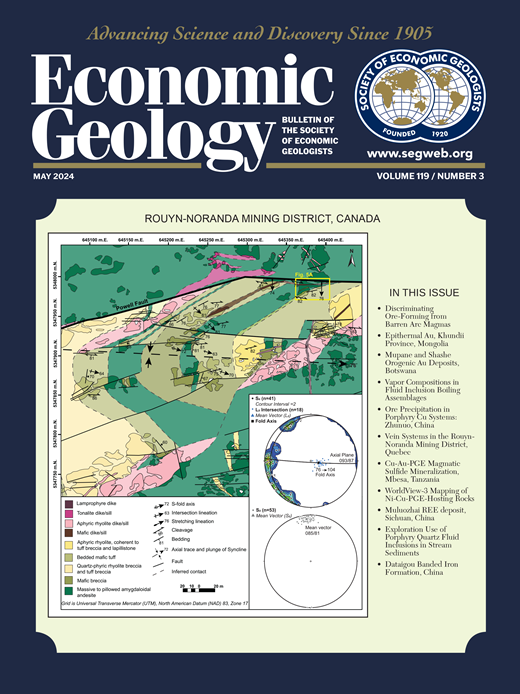墨西哥莫雷罗州Limon、Guajes和Media Luna金矿床的岩浆作用和矽卡岩形成时间
IF 5.5
1区 地球科学
Q1 GEOCHEMISTRY & GEOPHYSICS
引用次数: 2
摘要
Morelos地区位于墨西哥南部Guerrero州的Guerrero金矿带的中心,最近发现了几个与上白垩纪-古新世花岗闪长岩侵入有关的金±铜矽卡岩(总计约8.5 Moz Au)。沿El Limon花岗闪长岩与沉积寄主岩接触发育了Limon、Guajes和Media Luna夕卡岩矿床。原生金与石榴石辉石夕卡岩的逆行蚀变有关,伴生有原生铋、碲化物和硫化物矿物。该矿床具有明显的富镁矽卡岩矿物学特征,除金和银外,铜平均含量为~1 wt %。这将其与格雷罗金带的其他纯金矽卡岩矿床区别开来。这一观察结果表明,代替富镁沉积原岩的Guerrero金带夕卡岩,除含金外,还可能蕴藏着重要的铜资源。El Limon花岗闪长岩的激光烧蚀-电感耦合等离子体质谱(LA-ICP-MS)锆石年龄范围为66.86±0.40 ~ 65.88±0.79 Ma。Preskarn辉钼矿-石英脉穿过El Limon花岗闪长岩,产Re-Os辉钼矿年龄在66.63±0.22 ~ 65.55±0.25 Ma之间。El Limon花岗闪长岩中侵入了一系列斑岩脉,锆石年龄为65.9±1.1 ~ 64.68±0.38 Ma。利用U-Pb LA-ICP-MS对石榴石进行分析,确定了Limon和Media Luna的矽卡岩形成时间为64.6±1.2 ~ 63.2±1.0 Ma。在矽卡岩矿床中普遍存在石榴石,就地地质年代学的时间和成本效益是该方法约束成矿时间的显著优势。本文章由计算机程序翻译,如有差异,请以英文原文为准。
Timing of Magmatism and Skarn Formation at the Limon, Guajes, and Media Luna Gold ± Copper Skarn Deposits at Morelos, Guerrero State, Mexico
The Morelos district, located in the center of the Guerrero gold belt, Guerrero State, southern Mexico, has been the site of several recent gold ± copper skarn discoveries (total of ~8.5 Moz Au) associated with Upper Cretaceous-Paleocene granodiorite intrusions. The Limon, Guajes, and Media Luna skarn deposits developed along the contact of the El Limon granodiorite and the sedimentary host rocks. Native gold is associated with retrograde alteration of garnet-pyroxene skarn and is accompanied by native bismuth as well as telluride and sulfide minerals. The Media Luna deposit is characterized by a distinct magnesium-rich skarn mineralogy and contains an average of ~1 wt % Cu, in addition to gold and silver. This distinguishes it from the other gold-only skarn deposits in the Guerrero gold belt. This observation suggests that skarns in the Guerrero gold belt, which replaced magnesium-rich sedimentary protoliths, may host significant copper resources in addition to gold.
Uranium-lead laser ablation-inductively coupled plasma-mass spectrometry (LA-ICP-MS) zircon ages of the El Limon granodiorite range from 66.86 ± 0.40 to 65.88 ± 0.79 Ma. Preskarn molybdenite-quartz veins cut through the El Limon granodiorite and yield Re-Os molybdenite ages between 66.63 ± 0.22 and 65.55 ± 0.25 Ma. A series of pre-, syn-, and postskarn porphyritic dikes intruded the El Limon granodiorite, having zircon ages ranging from 65.9 ± 1.1 to 64.68 ± 0.38 Ma. The timing of skarn formation at Limon and Media Luna was constrained to 64.6 ± 1.2 to 63.2 ± 1.0 Ma, applying U-Pb LA-ICP-MS to garnet. The ubiquitous presence of garnet in skarn deposits and the time- and cost-efficiency of in situ geochronology are striking advantages of this method to constrain the timing of mineralization.
求助全文
通过发布文献求助,成功后即可免费获取论文全文。
去求助
来源期刊

Economic Geology
地学-地球化学与地球物理
CiteScore
10.00
自引率
6.90%
发文量
120
审稿时长
6 months
期刊介绍:
The journal, now published semi-quarterly, was first published in 1905 by the Economic Geology Publishing Company (PUBCO), a not-for-profit company established for the purpose of publishing a periodical devoted to economic geology. On the founding of SEG in 1920, a cooperative arrangement between PUBCO and SEG made the journal the official organ of the Society, and PUBCO agreed to carry the Society''s name on the front cover under the heading "Bulletin of the Society of Economic Geologists". PUBCO and SEG continued to operate as cooperating but separate entities until 2001, when the Board of Directors of PUBCO and the Council of SEG, by unanimous consent, approved a formal agreement of merger. The former activities of the PUBCO Board of Directors are now carried out by a Publications Board, a new self-governing unit within SEG.
 求助内容:
求助内容: 应助结果提醒方式:
应助结果提醒方式:


